Battenburg markings
Battenburg markings or Battenberg markings[lower-alpha 1] are a pattern of high-visibility markings developed in the United Kingdom in the 1990s and currently seen on many types of emergency service vehicles in the UK, Crown dependencies, British Overseas Territories and several other European countries such as the Czech Republic, Iceland, Sweden, Germany, Romania, Spain, Ireland, and Belgium as well as in New Zealand, Australia, Hong Kong and Trinidad and Tobago. The name comes from its similarity in appearance to the cross-section of a Battenberg cake.
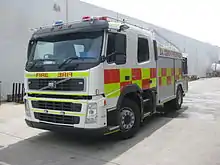
History
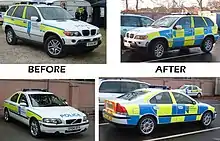
Battenburg markings were developed in the mid-1990s in the United Kingdom by the Police Scientific Development Branch (now the Home Office Centre for Applied Science and Technology) at the request of the national motorway policing sub-committee of the Association of Chief Police Officers. They were first developed for traffic patrol cars for United Kingdom police forces; private organisations and civil emergency services have also used them since then.
The brief was to design a livery for motorway and trunk road police vehicles that would maximise the vehicles' visibility, from a distance of up to 500 metres (1,600 ft), when stopped either in daylight or under headlights, and which distinctively marked them as police vehicles.[1]
The primary objectives were to design markings that:[2]
- Made officers and vehicles more conspicuous (e.g. to prevent collisions when stopped)
- Made police vehicles recognisable at a distance of up to 500 metres (1,600 ft) in daylight
- Assisted in high-visibility policing for public reassurance and deterrence of traffic violations
- Made police vehicles nationally recognisable
- Were an equal-cost option compared to existing markings
- Were acceptable to at least 75% of the staff
Conspicuity
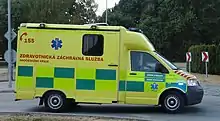
Battenburg design uses a regular pattern and the contrast between a light and a dark colour to increase conspicuity for the human eye. The lighter colour is daylight-fluorescent (such as fluorescent-yellow) for better visibility in daytime, dusk and dawn. For night-time visibility, the complete pattern is retroreflective.
The Battenburg design typically has two rows of alternating rectangles, usually starting with yellow at the top corner, then the alternating colour, along the sides of a vehicle. Most cars use two block rows in the design (so-called full-Battenburg scheme). Some car designs use a single row (so-called half-Battenburg scheme) or one and a half rows.
Unless precautions are taken, pattern markings can have a camouflage effect, concealing a vehicle's outline, particularly in front of a cluttered background.[3][4] With Battenburg markings, this can be avoided by:
- Making rectangles large enough for optical resolution from distance—at least 600 × 300 mm.[1] A typical car pattern consists of seven blocks along the vehicle side. (An odd number of blocks also allows both top corner blocks to be the same fluorescent colour.)
- Clearly marking cars' outlines in fluorescent colour along the roof pillars
- Avoiding designs with more than two block rows (even for higher vehicles) by including a large area of plain or daylight-fluorescent colour.
- Avoiding hybrid designs of Battenburg markings and other high-visibility patterns or check patterns.[2]
The Battenburg livery is not used on the rear of vehicles; upward-facing chevrons of yellow and red are most commonly used there.
Sillitoe tartan
_Evoke_sedan%252C_Victoria_Police_(2015-01-02).jpg.webp)
In the development of Battenburg markings, one of the key goals was to clearly identify vehicles associated with police. In this regard, the pattern was reminiscent of the Sillitoe tartan black-and-white or blue-and-white chequered markings first introduced by the City of Glasgow Police in the 1930s, which were subsequently adopted as a symbol of police services throughout the United Kingdom; they are also used by the Chicago Police Department, Australia,[5] and New Zealand. (Although Sillitoe patterns identified vehicles associated with police and other emergency services, they were not highly visible.)
After the launch of Battenburg markings, police added retro-reflective Sillitoe tartan markings to their uniforms, usually in blue and white.
Safety
_Nationaal_Defil%C3%A9_2018.jpg.webp)
Battenburg side markings and chevron front-and-rear markings provide conspicuity for emergency vehicles, helping to reduce accidents, especially when they are in unusual traffic situations—e.g. stopped in fast-moving traffic, or moving at different speeds or in different directions.
Several criticisms of the Battenburg scheme were stated at the 3rd Annual US Emergency Medical Services (EMS) Safety Summit in October 2010 about their use on ambulances, including:
- The difficulty of applying them to small, curved, and oddly-shaped surfaces
- The high costs of adopting the markings
- The confusing pattern caused when several parked Battenburg vehicles visually overlap
- Obscuring the vehicle's shapes against complex backgrounds, or with open doors and hatches
- Combinations other than police yellow-and-blue being less effective, and sometimes even making emergency personnel harder to see
- Confronting the public with unfamiliar markings
The pattern's use by services other than UK police, and in other countries, was also criticised.
The high-visibility chevrons often used on the rear and front of Battenburg-marked vehicles, "through popular opinion rather than by a scientific process of testing and research", were found ineffective at reducing rear-end collisions. Stationary vehicles on high-speed roads were likely to be noticed, but not the fact that they were stopped. Parking at an angle was found a far more effective way of indicating the vehicles were stopped.[2]
Usage by country
Australia
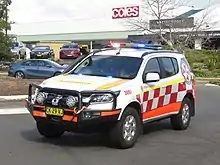
In Western Australia, St John Ambulance Western Australia uses green-and-yellow markings, while New South Wales Ambulance uses red-and-white Battenburg markings on ambulances and patient transport vehicles.[6] Australian police utilise the similar Sillitoe tartan markings.
| Common Battenburg markings used in Australia | ||
| St John Ambulance Western Australia | Yellow and green | |
| New South Wales Ambulance | Red and white | |
| South Australian Country Fire Service | Yellow and orange | |
Belgium
_Nationaal_Defil%C3%A9_2018.jpg.webp)
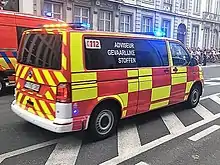
In response to the terrorist attacks on 13 November 2015 in Paris and 22 March 2016 in Brussels, the Belgian federal government conducted an analysis on the functioning of the emergency services during terrorist attacks. The main issue identified regarding the emergency medical services was that their recognizability (of both vehicles and personnel) had to improve, so that emergency workers would be able to identify qualified medical providers more quickly during an intervention.
An agreement was made between the federal government and the communities and regions to implement the same new vehicle markings and uniforms. Specifically, emergency ambulances and response vehicles would keep the yellow base colour, whilst non-emergency ambulances would get a white base colour. Both types of vehicles would be marked with retroreflective yellow-and-green Battenburg markings, similar to British ambulances.
A new uniform for medical personnel was also introduced, with different colours for the Star of Life for the different types of workers.[7]
Aside from medical vehicles, some new fire brigade, Civil Protection and highway services vehicles also use respectively yellow-and-red, blue-and-orange and yellow-and-black Battenburg markings.
| Common Battenburg markings used in Belgium | ||
| Emergency medical services | Yellow and green | |
| Police force (Antwerp)[8] | Yellow and blue | |
| Uncommon Battenburg markings used in Belgium | ||
| Fire services | Yellow and red | |
| Roadside assistance
Taxicabs in Brussels |
Yellow and black | |
| Belgian Civil Protection | Orange and blue | |
.jpg.webp)
China
Hong Kong was a British Dependent Territory until 1997. Some emergency vehicles and special vehicles in the Hong Kong Police Force, Hong Kong Fire Services Department, Auxiliary Medical Service, and Hong Kong St. John Ambulance use Battenburg markings.
| Common Battenburg markings used in Hong Kong | ||
| Police Force, Traffic Branch Headquarters | Yellow and blue | |
| Police Force, a few other vehicles | White and blue | |
| Fire Services Department, Mobile Casualty Treatment Centre | Yellow and green | |
| Fire Services Department, Hazmat Tender, and Fire Motorcycle | Yellow and red | |
| Fire Services Department, Mobile Publicity Unit, and Fire Safety Education Bus | ||
| Fire Services Department, Emergency Medical Assistant Motorcycle, Rapid Response Vehicle and Paramedic Equipment Tender | ||
| Fire Services Department, Mobile Command Unit, and Forward Command Car | White and red | |
| Auxiliary Medical Service, Paramedic motorcycle | Yellow and green | |
| Hong Kong St. John Ambulance, Ambulance | ||
Czech Republic
| Common Battenburg markings used in the Czech Republic | ||
| Emergency medical services | Yellow and green | |
Denmark
Danish emergency vehicles can have one of two options: a series of diagonal lines, or a Battenburg pattern. The diagonal lines must be either red-and-white or red-and-yellow at an angle of 45° ± 5° and have a width of 100 mm ± 2,5 mm. In the front and rear of the vehicle, the markings must be made symmetrical in a way that traffic is lead around the vehicle.[9]
| Battenburg markings used in Denmark | ||
| Police | Yellow and blue | |
| Ambulances, doctor cars and similar | Yellow and green | |
| Fire Department | Yellow and red | |
Vehicles may have a reflective text in the above colours, describing their function; for example "POLITI" (Police), "ALARM 112", "AMBULANCE", "LÆGEVAGT" (Doctor), "INDSATSLEDER" (Incident Commander) or similar text.
The above patterns are not obligatory. For example the Danish Emergency Management Agency have chosen to simply not have any reflective marking on their vehicles.
Germany
All rescue vehicles in Bavaria which have been procured uniformly since 2017 have a foiling in the Battenburg marker.[10] From 2019 the ambulance service in Schleswig-Holstein started to adapt the design.
| Bavarian Red Cross
Schleswig-Holstein Ambulance |
Orange and yellow |
Iceland
In 2018 the Icelandic police started marking new police cars with blue and neon yellow markings similar to Battenburg markings used in Europe. Since then the police cars in the capital region have been made even more visible. In 2020 were Icelandic ambulances changed to look more like ambulances in Europe, adopting yellow and green markings. Icelandic Search and Rescue started adopting Battenburg markings in 2016 with red and yellow markings similar to the fire services.
| Battenburg markings used in Iceland | ||
| Police | Yellow and blue | |
| Ambulances | Yellow and green | |
| Fire Department | Yellow and red | |
| Icelandic SAR | ||
Ireland
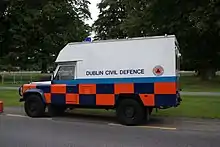

In Ireland, a similar system to the UK is used with some variations.
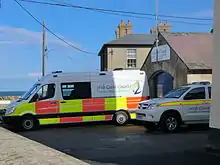
| Common Battenburg markings used in Ireland | |||
| Battenburg | Service | Colours | Example |
|---|---|---|---|
| Garda Síochána (police) Airport Police Service |
Yellow and blue | 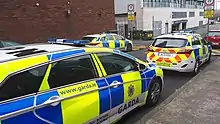 | |
| HSE National Ambulance Service | Yellow and green | 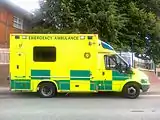 | |
| Fire and Rescue Order of Malta |
Yellow and red |  | |
| Civil Defence | Blue and orange |  | |
| Coast Guard | Orange and yellow |  | |
| Mountain Rescue | White and orange | ||
| Red Cross | Red and blue | ||
New Zealand
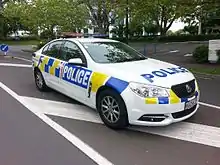
The New Zealand Police use yellow-and-blue Battenburg markings on some vehicles.[11] Until October 2008 general duties vehicles were marked in orange and blue, with yellow and blue for highway patrol units; orange and blue was phased out in 2014.[12] Vehicles of New Zealand's St John's Ambulance Service/ Wellington Free Ambulance are marked with green-and-yellow Battenburg markings or rows of green-and-yellow half-chevrons. On 1 July 2017, New Zealand's urban and rural firefighting organisations amalgamated into Fire and Emergency New Zealand, with a new brand including Battenburg markings to be rolled out to the fleet.[13]
| Common Battenburg markings used in New Zealand | ||
| Police | Yellow and blue | |
| St John Ambulance/Wellington Free Ambulance | Yellow and green | |
| Fire and Emergency New Zealand | Yellow and red | |
Sweden
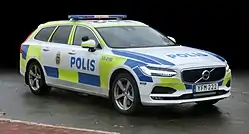
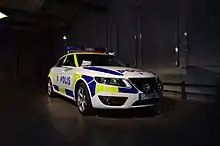
Originally Swedish Police vehicles were painted with black roofs and doors or black roofs, bonnet, and boot. During the 1980s the cars became white with the word "Polis" written on the side in a semi-futuristic typeface. Later the livery became simply blue and white. In 2005 they began using a light blue and fluorescent yellow Battenburg livery. Swedish police cars have been Saabs, Volvos or Volkswagens, with the same livery all over Sweden. A recent Swedish trend is to also use Battenburg markings on road maintenance vehicles, with an orange-and-blue colour scheme, as in the UK rail response type shown above. A study by the Swedish Road Administration showed a significant traffic calming effect when using orange-and-blue Battenburg marking to improve the visibility of road maintenance vehicles.[14]
| Common Battenburg markings used in Sweden | ||
| Police | Yellow and blue | |
| Ambulance | Yellow and green | |
| Fire Brigade | Yellow and red | |
| Road maintenance | Blue and orange | |
Switzerland
.jpg.webp)
The first Swiss ambulance service with Battenburg markings was the emergency medical services in Zofingen. Since 2008, they have used Battenburg markings on their Volkswagen Crafters and Mercedes-Benz Sprinters. They use white-and-red markings on their ALS units.
Another Swiss service with Battenburg markings is the Swiss Border Guard agency, which uses yellow block markings on its vehicles.
| Common Battenburg markings used in Switzerland | ||
| Swiss Border Guard | Yellow and navy blue | |
United Kingdom
.jpg.webp)
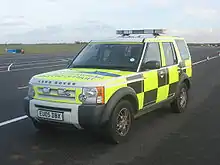
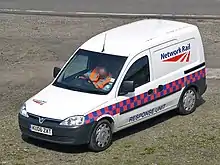
In the United Kingdom, the majority of the emergency services have adopted the Battenburg style of markings; nearly half of all police forces adopted the markings within three years of their introduction, and over three quarters were using it by 2003.[1]
In 2004, following the widespread adoption and recognition of the Battenburg markings on police vehicles, the Home Office recommended that all police vehicles, not just those on traffic duty, use "half-Battenburg" livery, formalising the practice of a number of forces.
In the United Kingdom each emergency service has been allocated a specified darker colour in addition to yellow, with the police continuing to use blue, ambulances using green, and the fire service their traditional red. Other government agencies such as immigration enforcement have adopted a variation, without using the reflective yellow.[15]
The use of these colours in retro-reflective material is controlled by the Road Vehicle Lighting Regulations 1989, with vehicles only legally allowed the use of amber reflective material (and red near the rear of the vehicle),[16][17] A number of civilian organisations have also adopted the pattern, which is not legally protected, and a number of these also use other reflective colours.
An alternative to the use of reflective materials is the use of fluorescent or other non-reflective markings, which may be used by any vehicle.
| Common Battenburg markings used in the United Kingdom[18][19] | |||
| Battenburg | Service | Colours | Example |
|---|---|---|---|
| Police Forces | Yellow and blue | ||
| Ambulance and Doctors | Yellow and green | .jpg.webp) | |
| Fire and Rescue | Yellow and red | .jpg.webp) Red and yellow battenburg marking on a London Fire Brigade appliance | |
| NHS Blood and Transplant, Blood Bikes and some 4×4 responders | Yellow and orange | 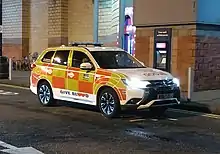 | |
| National Highways traffic officers, Welsh Government traffic officers and DVSA | Yellow and black |  | |
| Rail Response | Orange and blue |  | |
| Mountain Rescue, Lowland Rescue, and Cave Rescue and most 4×4 responders | White and orange[19][20][21][22] |  | |
| HM Coastguard | Yellow and navy blue | .jpg.webp) | |
| Immigration Enforcement, Border Force, HM Customs and Excise | Sky blue and navy blue[15] |  | |
United States
Battenburg markings on law enforcement vehicles in the US are rare; however for a time the Miami Township Police Department in Ohio has previously used ones similar to those found in the UK on their police cars.[23]
Battenburg markings are also used in South Carolina's Charleston County for EMS vehicles.[24]
Canada
Similar story in Canada, Battenburg markings on law enforcement vehicles are also rare and uncommon just like in the US; however unlike the US, Canada has slowly integrated more Battenburg markings on some of their EMS vehicles in recent decades, more notably Ontario and Québec. Other parts of Ontario that utilizes the Battenburg markings in their vehicles vary by region and city, such as the Region of Niagara,[25] Greater Sudbury,[26] Peterborough,[27] Lanark County,[28] and Frontenac County[29] all uses half-Battenburg markings on some of their EMS Vehicles. While the province of Québec uses half the Battenburg markings on almost all of their EMS vehicles provincewide and not by region.[30] According to the article on June 4, 2021, the St. Thomas Police Department in the province of Ontario had tested out their new Police cruisers with the new Battenburg markings. Inspired by the UK's Battenburg design with the familiar blue and yellow reflective markings in order to help enhance visibility within the city.[31][32]
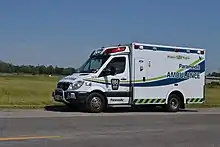 A Mercedes-Sprinter Ambulance in Niagara Region uses half-Battenburg markings.
A Mercedes-Sprinter Ambulance in Niagara Region uses half-Battenburg markings.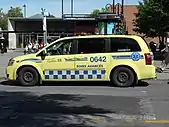 A Dodge Caravan half-Battenburg marking EMS vehicle used in Québec.
A Dodge Caravan half-Battenburg marking EMS vehicle used in Québec.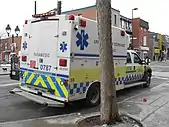 A paramedic truck parked in Montréal with the Battenburg markings.
A paramedic truck parked in Montréal with the Battenburg markings.
References
- The cake was named after the Battenberg family, in turn named after the town of Battenberg. "Battenburg" with a "u" is a misspelling of the family name, but an acceptable spelling for the markings.
- Harrison, Paul (2004). "High-Conspicuity Livery for Police Vehicles" (PDF). Home Office. Archived from the original (PDF) on July 18, 2009.
{{cite journal}}: Cite journal requires|journal=(help) - John Killeen. "Evaluating new trends in emergency vehicle markings - Advertising agency visibility, Battenburg markings and the Chevron debate" (PDF).
Summary for the Colorado, US EMSAC community of information presented at the October 2010 3rd Annual US EMS Safety Summit
- "Emergency Vehicle Visibility and Conspicuity Study, FA-323" (PDF). U.S. Department of Homeland Security. August 2009. Retrieved 2015-01-26.
- "The difference between Battenburg high-visibility markings and Sillitoe chequers on Police, Fire & Ambulance vehicles". 2012-04-27. Retrieved 2015-01-26.
- Emergency Vehicle Markings in Australia
- http://www.stjohnambulance.com.au
- "Ambulances en personeel letterlijk in een nieuw jasje" [Ambulances and personnel get a new look]. De Standaard (in Dutch). 2017-03-28. Retrieved 2017-11-19.
- Slegers, Sharon. ""Battenburgpatroon" maakt 40 nieuwe combi's van politie Antwerpen ultrazichtbaar". VRT. Retrieved 26 January 2021.
- "Retsinformation" (in Danish). 2021-05-31.
- "Rettungswagen Bayern 2017" [Ambulances in Bavaria 2017]. BRK (in German). 2016-12-13. Retrieved 2018-02-09.
- "New Zealand police vehicle markings and livery". Driving Tests Resources. 2016-05-30. Retrieved 2016-05-29.
- Binning, Elizabeth (11 November 2008). "Arresting image update to save police force $800,000". New Zealand Herald.
- "Getting to the heart of who were are – Fire and Emergency's new identity" (PDF). The FENZ Transition Project. 2017-04-27. Archived from the original (PDF) on 2018-01-28. Retrieved 2017-05-09.
- "Improved visibility of road maintenance vehicles using Battenburg markings (report in Swedish)" (PDF). Archived from the original (PDF) on 2014-02-22.
- Photograph of Home Office Immigration Enforcement vehicle
- "Road Vehicles Lighting Regulations 1989: Schedule 17".
- although the emergency services operate under temporary special orders under section 44 of the Road Traffic Act 1988 to use their own colours, with moves underway as of 2008 to formalise this in legislation and extend the use of other colours to civilian operators.Burrows, Adrian (2008-03-07). "Impact Assessment of the Road Vehicle Lighting Regulations covering reflective markings on emergency vehicles" (PDF). Department for Transport. Archived from the original (PDF) on 2009-12-03.
{{cite journal}}: Cite journal requires|journal=(help) - "Emergency Services". Vehicle Livery Solutions. Archived from the original on 20 November 2016. Retrieved 20 November 2016. Illustrations of patterns supplied to emergency services.
- "Mountain Rescue". Uk Emergency Vehicles. 24 August 2010. Retrieved 21 November 2016.
- "Search and rescue charity gets vital boost in funds from police force". 29 May 2020.
- "Berkshire Lowland Search and Rescue given cash for equipment". BBC News. 20 February 2020.
- "Donation to fund new equipment for search and rescue service". 20 June 2020.
- "Miami Township Police Department". 30 July 2012.
- "Medic Stations | Emergency Medical Services (EMS)".
- "Niagara EMS not looking at using first-year paramedic students". stcatharinesstandard.com. 2020-04-19. Retrieved 2022-03-27.
- "Ruff ruff rescue: Paramedic pulls two dogs from home next to raging shed fire". Sudbury.com. Retrieved 2022-03-27.
- PTBOCANADA. "Peterborough Paramedics First in North America To Pilot Next Generation Integrated Driving Experience". PtboCanada. Retrieved 2022-03-28.
- Kulp, Ashley (2021-03-20). "How many calls did Lanark County Paramedic Service respond to in 2020?". The Toronto Star. ISSN 0319-0781. Retrieved 2022-03-27.
- "Paramedics in Kingston say employee assaults are on the rise - Kingston | Globalnews.ca". Global News. Retrieved 2022-03-27.
- "Soins préhospitaliers d'urgence avancés - Université de Montréal - Guide d'admission". admission.umontreal.ca. Retrieved 2022-03-27.
- "St. Thomas police testing out new cruiser paint design". London. 2021-06-04. Retrieved 2022-03-26.
- staff, 94 1 myFM News. "STPS goes Battenburg to increase visibility as part of new pilot project". 94.1 St.ThomasToday.ca. Retrieved 2022-03-26.
External links
| Wikimedia Commons has media related to Battenburg markings. |
.jpg.webp)